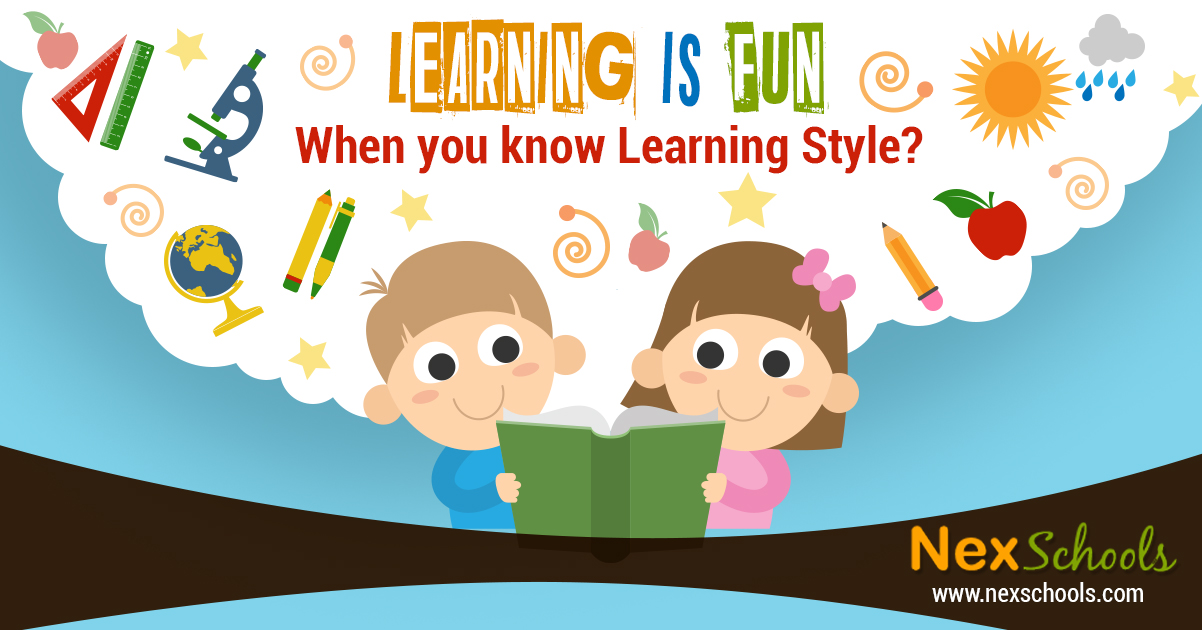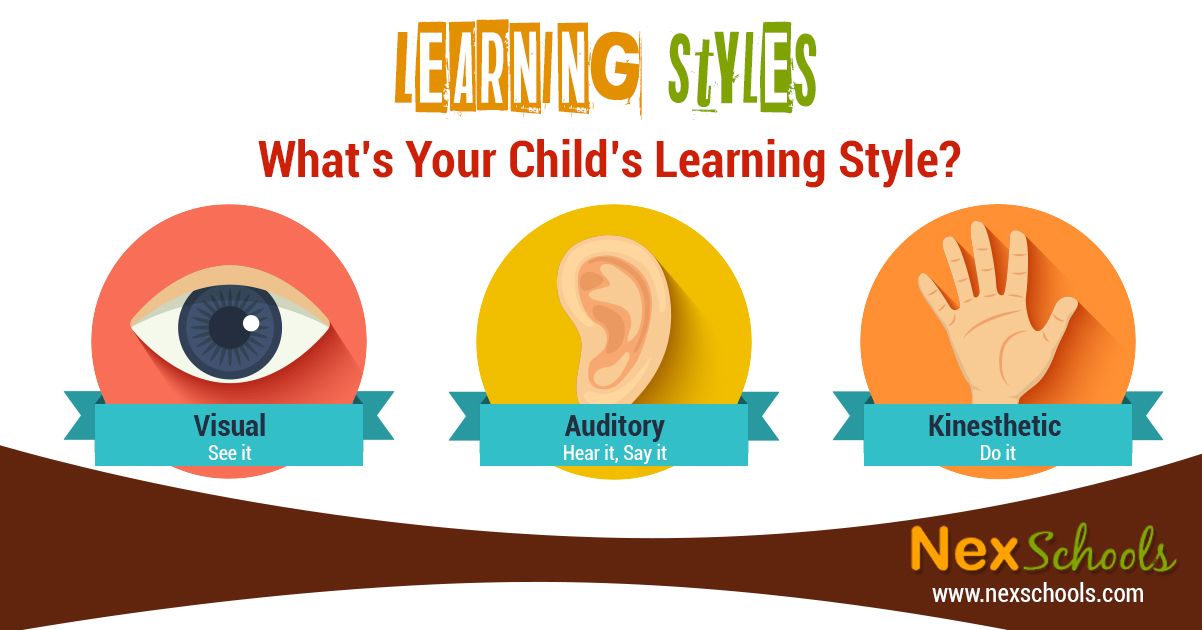
Did you know there are many different ways to learn? In fact, most of us have a dominant way we absorb information and learn. Understand your child’s preferred learning style to make the learning fun.
There are many senses our brain use to receive and process information. It is very important for teachers and parents to recognize child’s learning style while teaching or assigning homework. Once you know the learning style of the child, you can maximize the capability of learning and enhance it to the maximum for education. Children can better understand their learning and can adapt to the learning environment.
What is learning style?
Every child has different ways of learning. It is an individual preference how a person understands, processes, and retains information. “Learning Style” refers to the trait of understanding that a student possesses and learns the things around by optimizing that sense of understanding. According to Indian scholar and spiritual guru, Swami Vivekananda, ‘every child is perfect right from his birth; he/she discovers that quality by the attainment of learning and knowledge with age’. This keeps every child at par. The only point of distinction is ‘style of learning’. Parents need to ascertain their children’s learning style to help them grasp, comprehend, and retain things in a prompt manner in times of cut-throat competition. While dealing with the learning styles, parents must take a note of that there are various factors that affect these styles, namely, emotional, environmental, cognitive, and past experiences. These factors also distinguish one child from another.

Education experts have grouped it in the three broad categories:
Auditory Learners
These children will learn anything they hear. They are great listeners and retain a higher amount of information when explained in detail. Tap into auditory listeners desires to talk and talk by doing an activity.
Visual Learners
The children can recall things they have seen fall into the category of visual learners. They enjoy and learn fast when visual representations of information are used to understanding key concepts such as pictures, graphs, diagrams or color layout.
Kinetic or Kinesthetic Learners
The children who love to touch or experience things in order to make concepts stick they learn best by hands-on activities and experiences.
Vitals Aspects to Distinguish Learners
Prior to discovering learning styles and chalking out teaching methods accordingly, it is highly important to pay heed to a few vital points. Before proceeding ahead, the teacher must analyze the thinking process of a student because it highly affects the way a child grasps and learn the things coming his/her way. A teacher must try differentiating students on the basis of their personality patterns. This will help a teacher ascertain how a particular student behaves or reacts in a given situation or how differently he/she acts from others. A teacher must keep an eye on how a student interacts with other. On the grounds of social interaction, a student may fall under myriads of categories: participant, independent, competitive, avoidant, collaborative and dependent.
Types of Learning Styles
There are majorly seven learning styles: visual, aural, verbal, physical, logical, social, and solitary. Students are believed to possess combinations of these learning styles and this amalgamation demands that teacher must ascertain the patterns in students’ preferences towards the above-said learning styles. Once a teacher successfully identifies students’ learning preferences, he/she should strive towards creating learning opportunities by using their learning styles. By and large, teacher and student must share a field of commonality, as far as teaching to various learning styles is concerned.
Learning Styles and Their Corresponding Teaching Styles
Visual Learners
A student preferring visual learning style is more inclined towards visual or observatory material to strengthen their grip on facts and concepts. Thus, visual learners gain more when they read, see or observe things. Eyes are the dominant faculty for them to grasp things promptly.
(a) To appeal them, a teacher can use flow charts, cartoons, maps, and flashcards.
(b) Use of different fonts and writing style would also help. It would accentuate the readability of the content.
(c) To identify organizational patterns, a teacher may also teach them to make it a habit to highlight vital part of information or keywords.
(d) Using chalkboard while conveying and teaching things would also do a lot for them.
Auditory Learners
For auditory learners, ears are the dominant faculty and listening is the most advantageous way of learning things. Thus, they are more inclined towards discussions, or spoken words, instead of reading or observance. Teaching strategies for such learners must be like:
(a)A teacher must encourage such students to actively take part in discussions regarding the subject matter.
(b)A teacher must cross-examine their knowledge by asking them as many questions as possible.
(c) Variation in expressions while conversing with them would break the monotony and evoke humongous interest in them.
(d)A teacher must ask such learners to repeat vital information every now and then. They should be taught oral summaries.
(e) Allow them to record the lectures for future reference.
(f) Use of catchy words and phrases will appeal to them.
Kinesthetic Learners
The sense of touch or feel is very dominant in kinesthetic or tactile learners. Thus, physical experience does a lot for this sort of learners. Teaching strategies for such learners are quite different from the rest of the two categories, like,
(a) Tactile learners are best benefitted from discovery on their own.
(b) Building models and tools are said to be most lucrative for such students.
(c)A teacher must incorporate laboratory experiments and field trips in their curriculum.
(d) Bodily movements, like, pacing or finger snapping, showcasing by teachers would help students grasp the lesson easily and promptly.
(e) Dramas and roleplays also help these learners to understand the concepts without any struggle and memorize them for long.
Thus, by analyzing the preferred learning styles of your students, tailoring your teaching styles & techniques with them and establishing integration between both the styles, you will help them greatly and accentuate their capacity to grasp and memorize things for quite long.
A Pa rent is also asking:
rent is also asking:
How about the quality of homework or assignments are given to do at home? Isn’t it time to weigh the quality of assignments given by schools to complete at home?
Answer Now
Share on WhatsApp
VARK Model By Fleming and Mills
To get a hang of individual styles of learning, we would like to throw light on the modalities propounded by Fleming and Mills. They proposed VARK model for learning information where the acronym stands for Visual, Auditory, Read or Write, and Kinesthetic. The model suggests that children have different ways to process information as they have different learning modes. These learning models have a vital influence on the conduct and learning of every child. Parents should make sure that these learning modes must be in accordance with their chosen learning strategies. You would be able to witness a considerable increase in the levels of motivation and comprehension after processing information through their preferred modes.
SWOT Strategies By Fleming
Fleming also proposed SWOT Strategies (i.e., Study Without Tears) which are believed to be lucrative for students and help them know how to use learning modalities in the best possible way.
Visual SWOT Strategies
a. Make the optimum use of graphics or cognitive organizers, namely, mind maps, graphs, charts, Venn diagrams, concept maps, webs, and many more. Graphic organizers are believed to be highly efficient visual learning strategies which deepen the understanding and strengthen the learning of concepts and facts. These are also treated as instructional tools as they accentuate the writing & thinking prowess of children.
b. Children must be taught to substitute keywords with symbols.
c. Children should be taught to make use of colors to accentuate vital key terms.
Aural SWOT Strategies
a. Whatever children have learnt or summarized, they must record it so that they can listen to it time and again and memorize the things for a long span.
b. Students must make it a habit to discuss things with their friends or peers to widen the horizon of their understanding of the things.
c. Students must read out their hand-written or recorded notes loud again and again.
d. If you have some friends whom you can call great aural listeners, then you can ask them for a favor and explain your learnt things to them.
Read or Write SWOT Strategies
a. Rewrite your notes as much as possible.
b. Always make it a habit to jot down the core ideas time and again so as to attain a firm grip on the main principle underlying.
c. Try to comprehend the visual data available into meaningful statements without altering the meaning of the message conveyed through these visual organizers.
Kinesthetic SWOT Strategies
a. To deduce the right interpretation of the idea underlying in the information conveyed and to have the gist of abstract concepts, make use of examples from your daily life in your summary of notes.
b. Perform lab experiments time and again.
c. To exemplify your core ideas, make use of photographs and pictures.
For the Teachers
As per our educational science, both teaching and learning are intricate processes. Complexity arises due to varied teaching as well as learning styles, and to achieve the desired results it is highly important that teaching style should be in line with students’ learning style. Thus, if a child is struggling with learning and adapting things, it directly calls the teaching style and procedure into question. Taking stock of the situation, one needs to assess how he/she can hone various teaching methods and styles so as to reach the maximum of students in a class and thus metamorphosing a classroom into an effective learning center.
 Parent Tips
Parent Tips
Children go through many arenas throughout the educational process. In the elementary school, they adjust to long hours of the school, structured time and increased demands from teachers. By the time they are settled well in the elementary school they progress to middle school, suddenly list of subjects’ increases with multiple teachers and increased homework.
When your child recognizes his or her unique learning style it does not only aids in ability to learn but also enhance their future ability. It also helps in excelling in learning without causing frustration and overcoming learning differences.